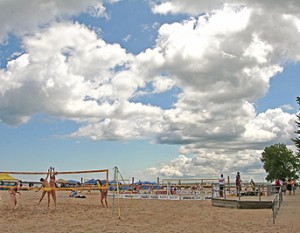To predict how much muck will wash up on Lake Ontario beaches in the summer, it might make sense to look at spring temperatures.
Lots of things cause algae — too many nutrients, zebra mussels, storms, sunlight. But new research suggests that earlier, warmer spring temperatures that quickly heat Lake Ontario’s nearshore areas spur summer growth of smelly, slimy algae.
And if that’s the case, Great Lakes beach managers have a long summer ahead.

Ontario Beach can be a fun place when it’s not covered in smelly algae. Photo: monroecounty.gov
When Lake Ontario’s nearshore waters warm rapidly in the spring, there are more beach closings prompted by an algae called cladophora, according to a study that will be published next month in the Journal of Great Lakes Research.
One reason is cladophora doesn’t grow when it’s cold so earlier warming gives the algae a head start, said Anthony Vodacek, study author and associate professor at the Rochester Institute Technology’s Center for Imaging Science.
Another possibility is that when the nearshore is warm and deeper water is cold, a vertical current between the two areas keep cladophora in the warmer, shallower waters, he said. Nutrient-laden sediment settles and lets more light through, which is necessary for algae growth.
Vodacek used data from 2000 to 2010 at Ontario Beach near Rochester, N.Y.
Charles Knauf, an environmental health analyst with the Monroe County, N.Y., Department of Health, gave Vodacek the data.
He is worried.
“If Tony’s (Vodacek) right, I’m not looking forward to this year as a beach manager,” Knauf said.
He said he and colleagues observed for many years that mild winters caused more summer beach algae. But they theorized that mild winters caused less disruption to invasive mussels, which spur algae growth by cleansing water resulting in more sunlight penetration.
And that may be true, Vodecek said. But for his study, the years that had more cladophora-induced beach closings did not have different mussel situations than years with fewer closings.
Vodacek said springtime satellite images — showing nearshore versus deeper water temperature differences – could let beach managers know how slimy their summer will be.
“This could really help people prepare for a bad cladophora year,” Vodacek said. “Cladophora clogs up water intake pipes and this could give officials warning to prepare for something like that.”
Beach managers could add staff if they knew they were in for a mucked-up summer, he added.
But, given the amount of factors in algae growth, Knauf is approaching the research tepidly.
“We could potentially add more staff … but we need more to go on than just this study,” Knauf said. “We’re in tough economic times … we just can’t take that chance.
“The government takes more time to do things for a reason … if we followed every study we saw out there, we would go down a lot of dead end lanes.”
This year is a good test to see if the earlier spring brings more cladophora, Knauf said.
“I’m 61, and I’ve never seen a winter like this,” he said.
Vodacek said that climate change could spur even more algae.
“If things keep getting warmer, and the winters are so warm that the lake doesn’t cool down much … it’s possible we could see even more of this phenomenon,” he said.
Knauf said he’s already getting algae calls because of the warm spring.
“We’ve already gotten two calls from local inland lakes that already have excess algae,” Knauf said. “We’re seeing algae that we usually deal with in mid-May.”
